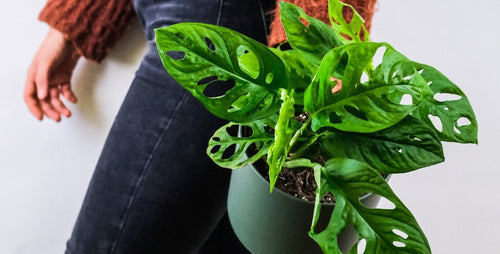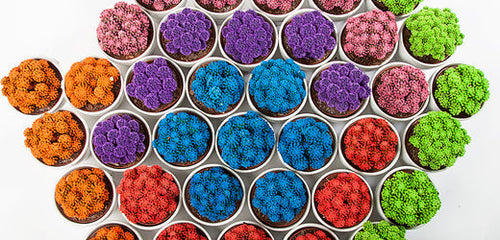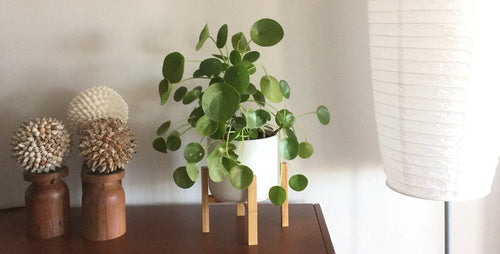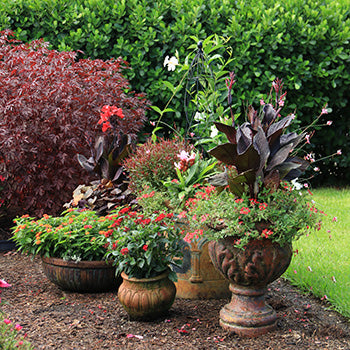
What are aphids?
Aphids are tiny insects, no larger than grains of sand. They have needlelike mouths that suck the juice from the cells in your plants. And because they also have 6 legs (oh, and wings!), they are mobile, so they can move from plant to plant.
Horticulturist Justin and Integrated Pest Management Manager Michelle weigh in on aphids, how to avoid them, where to find them on your plants, and what to do about them if you spot them on your plants.
Even plant pros have bouts of aphids. “Currently I have aphids for the first time ever,” says Michelle. “I made a rookie mistake. I put a philodendron out for the summer and brought it in with aphids.” Although aphids are small, they aren’t hard to see. They like to hang out on specific areas of your plants. “Look for them on the undersides of the leaves,” says Michelle. “And look at the new growth,” adds Justin; aphids prefer the delicious tender new leaves on plants.
Once you’ve discovered aphids on your plants, be assured that there are several ways to get rid of them. But the spoiler alert is this, says Justin. “No single treatment is going to be once and done.” Aphids reproduce quickly enough, he says, “so you will need to do whatever you do multiple times.” Here are several methods for aphid elimination.
Kill Aphids By Hand
Controlling aphids can be simple (yet, for some, a gross act). “I’m just smushing them,” says Michelle. This method “takes someone with a harder stomach,” she admits. And smushing them is not the best solution if you have a full blown infestation. “I’m doing that right now, because I don’t have whole lot of them,” says Michelle. “They are like little water bombs,” she says.

The Spray Method
Another method of hand control (that is not so gross, says Justin) is simply washing them off the leaves with a strong stream of water. “I manually wash them off with a strong stream of water with the kitchen sprayer or shower,” he says. “Once they get into the water, they are done for,” he says. But make sure they go into the water, warns Michelle. “Some aphids are surprisingly fast,” she says. “If you wash them off onto the soil, they will wander back up (onto the plant).”
Engage Biologicals (aka Beneficial Insects)
Biologicals are a natural pest control that pits good bugs against bad bugs. “I always recommend trying them,” says Michelle. The classic biocontrol for aphids are lacewings. “Don’t get the adults,” says Michelle, “because they aren’t carnivores so they won’t do anything. Get eggs and larvae,” she says. But “don't use ladybugs inside. Ladybugs released into your house will not perform for you,” she says. Parasitoids are little wasps that look like fungus gnats. “They can’t hurt you,” assures Michelle. “But they will go after aphids.” These beneficial insects are parasites and work by stabbing the aphid, inserting an egg into its body. When the egg hatches, the larvae eats the aphid from the inside out. The stuff of horror films, for sure, but safe and effective. If you go this route, think diversity. “There are a lot of different aphids, so get a mix of parasitoids,” recommends Michelle. Although biologicals may not work as well in the house as they do outdoors, because indoors “is not their natural environment” says Michelle, they are worth a try.
Employ Natural Pest Control
There are several types of natural pest control options. “Neem oil is a suffocant,” she says. “But you might find insecticidal soap works better,” advises Michelle. "Use a product that is labeled insecticidal soap,” she says. “Don’t use Dawn or Dr. Bronners,” she says about soaps that dish washing or liquid body soaps. “Pyrethrins shouldn’t be used indoors. And don’t use dusts indoors,” says Michelle. When using natural pest controls, take care to use a solution that fits your pest. And never, never over apply. More is not better when it comes to pest control chemicals. Justin recommends that you keep in mind that not all solutions work for all plants. Read the instructions that will indicate what plants you can’t use them on. For example, insecticidal soaps don’t work well on fuzzy plants and ferns.
Use a Systemic Drench
Another method of aphid elimination is a pest treatment that makes the plant itself poisonous to the pest, says Justin. “The chemical is absorbed within the system of the plant, making the plant poisonous to the insects that eat it,” he says. But there are compromises with this treatment, says Michelle. “If you drench with the chemical, then water heavily, it won’t give control,” she says. “And it takes a little longer (to work on aphids) because it has to be pulled up into the plant, then the aphids have had to eat the plant. And then they die,” she says. One other caveat: “Systemics are generally safe,” says Michelle. “But take care that your pets don’t drink the water that comes out of the bottom of the pot,” she says.
Stop Aphid Spread
Best practices are to inspect your plants regularly. If your plants are outdoors for the summer, check them closely before bringing them indoors. And know this: If you have aphids on one plant, you are likely to have them on another. Michelle and Justin both recommend that if you find aphids on one indoor plant, immediately isolate the plant with the infestation and check the surrounding plants. And because aphids can form alates – winged offspring – they can spread by air.
To hear the full discussion about aphids with Justin and Michelle, check out their RX podcast on YouTube.
Discover more about plant pests:
Plant Pests 101: Spider Mites
Plant Pests 101: Mealybugs
Aphid photo credit: Frank Peairs, Colorado State University, Bugwood.org

















